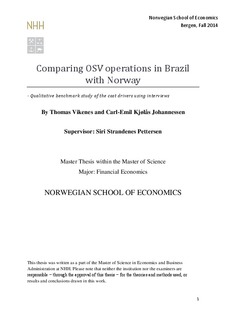Comparing OSV operations in Brazil with Norway : qualitative benchmark study of the cost drivers using interviews
Master thesis
Permanent lenke
http://hdl.handle.net/11250/277961Utgivelsesdato
2014Metadata
Vis full innførselSamlinger
- Master Thesis [4372]
Sammendrag
The objective of this thesis is to map the main drivers behind the operational and capital expenditures related to offshore support vessels in Brazil and in the North Sea. We compare the two regions using the North Sea as the benchmark.
Our study is qualitative and the data is gathered using semi-structured interviews with Norwegian offshore shipping companies, both in Brazil (Rio de Janeiro) and in Norway. Our findings are mainly based on information gathered in these interviews, but reports from shipbrokers and other financial institutions, together with interviews with other actors in the offshore shipping industry, are used to get a different perspective on the topic.
In the first part of our thesis, the external environment in the offshore shipping industry is analyzed. Three different analyses are performed assessing: the drivers behind the demand for offshore vessels, the attractiveness of the offshore shipping industry and how it is to do business for Norwegian shipowners in Brazil compared to Norway. In the second part, the company specific factors, OPEX and CAPEX, are analyzed. An investment case, evaluating whether to invest in a vessel in Norway or Brazil is presented at the end of this part.
Based on our analysis of the external environment in the offshore shipping industry, we find out that; the demand for offshore vessels is stagnating due to lower E&P spending, the attractiveness of the offshore shipping industry is low, and the difference between Norway and Brazil in terms of doing business is large.
Based on our analysis in the second part of our thesis, we conclude that both the OPEX and the CAPEX (Docking and Shipbuilding) related to the operation of a vessel is higher in Brazil than in the North Sea. The higher OPEX is mainly driven by higher crew and technical costs, and increased costs due to a challenging client. The higher docking cost is mainly driven by a lack of dry-docks, and issues related to the importation of equipment. The higher shipbuilding cost is driven by a low supply of commercial yards, delays in the shipbuilding process, and issues related to the importation of equipment.
In the investment case at the end of part two, our recommendation is that shipowners should invest in Norway rather than Brazil.
